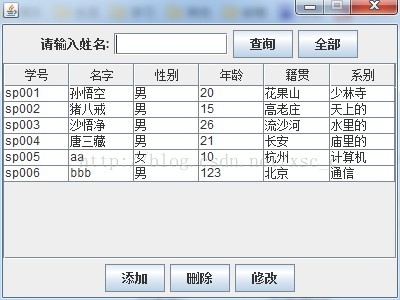本文实例讲述了php实现的pdo公共类定义与用法。分享给大家供大家参考,具体如下:
db.class.php :
?
|
1
2
3
4
5
6
7
8
9
10
11
12
13
14
15
16
17
18
19
20
21
22
23
24
25
26
27
28
29
30
31
32
33
34
35
36
37
38
39
40
41
42
43
44
45
46
47
48
49
50
51
52
53
54
55
56
57
58
59
60
61
62
63
64
65
66
67
68
69
70
71
72
73
74
75
76
77
78
79
80
81
82
83
84
85
86
87
88
89
90
91
92
93
94
95
96
97
98
99
100
101
102
103
104
105
106
107
108
109
110
111
112
113
114
115
116
117
118
119
120
121
122
123
|
<?php
class db extends \\PDO {
private static $_instance = null;
protected $dbName = '';
protected $dsn;
protected $dbh;
public function __construct($dbHost, $dbUser, $dbPasswd, $dbName, $dbCharset='utf8') {
try {
$this->dsn = 'mysql:host=' . $dbHost . ';dbname=' . $dbName;
$this->dbh = new \\PDO($this->dsn, $dbUser, $dbPasswd);
$this->dbh->setAttribute(\\PDO::ATTR_EMULATE_PREPARES, false);
$this->dbh->setAttribute(\\PDO::ATTR_ERRMODE, \\PDO::ERRMODE_EXCEPTION);
$this->dbh->exec('SET character_set_connection='.$dbCharset.';SET character_set_client='.$dbCharset.';SET character_set_results='.$dbCharset);
} catch (Exception $e) {
$this->outputError($e->getMessage());
}
}
public static function getInstance($dbHost, $dbUser, $dbPasswd, $dbName, $dbCharset='utf8') {
if (self::$_instance === null) {
self::$_instance = new self($dbHost, $dbUser, $dbPasswd, $dbName, $dbCharset);
}
return self::$_instance;
}
public function fetchAll($sql, $params = array()) {
try {
$stm = $this->dbh->prepare($sql);
if ($stm && $stm->execute($params)) {
return $stm->fetchAll(\\PDO::FETCH_ASSOC);
}
} catch (Exception $e) {
$this->outputError($e->getMessage());
}
}
public function fetchOne($sql, $params = array()) {
try {
$result = false;
$stm = $this->dbh->prepare($sql);
if ($stm && $stm->execute($params)) {
$result = $stm->fetch(\\PDO::FETCH_ASSOC);
}
return $result;
} catch (Exception $e) {
$this->outputError($e->getMessage());
}
}
public function fetchColumn($sql, $params = array()) {
$result = '';
try {
$stm = $this->dbh->prepare($sql);
if ($stm && $stm->execute($params)) {
$result = $stm->fetchColumn();
}
return $result;
} catch (Exception $e) {
$this->outputError($e->getMessage());
}
}
public function insert($table, $params = array(), $returnLastId = true) {
$_implode_field = '';
$fields = array_keys($params);
$_implode_field = implode(',', $fields);
$_implode_value = '';
foreach ($fields as $value) {
$_implode_value .= ':'. $value.',';
}
$_implode_value = trim($_implode_value, ',');
$sql = 'INSERT INTO ' . $table . '(' . $_implode_field . ') VALUES ('.$_implode_value.')';
try {
$stm = $this->dbh->prepare($sql);
$result = $stm->execute($params);
if ( $returnLastId ) {
$result = $this->dbh->lastInsertId();
}
return $result;
} catch (Exception $e) {
$this->outputError($e->getMessage());
}
}
public function update($table, $params = array(), $where = null) {
$_implode_field = '';
$_implode_field_arr = array();
if ( empty($where) ) {
return false;
}
$fields = array_keys($params);
foreach ($fields as $key) {
$_implode_field_arr[] = $key . '=' . ':'.$key;
}
$_implode_field = implode(',', $_implode_field_arr);
$sql = 'UPDATE ' . $table . ' SET ' . $_implode_field . ' WHERE ' . $where;
try {
$stm = $this->dbh->prepare($sql);
$result = $stm->execute($params);
return $result;
} catch (Exception $e) {
$this->outputError($e->getMessage());
}
}
public function delete($sql, $params = array()) {
try {
$stm = $this->dbh->prepare($sql);
$result = $stm->execute($params);
return $result;
} catch (Exception $e) {
$this->outputError($e->getMessage());
}
}
public function exec($sql, $params = array()) {
try {
$stm = $this->dbh->prepare($sql);
$result = $stm->execute($params);
return $result;
} catch (Exception $e) {
$this->outputError($e->getMessage());
}
}
private function outputError($strErrMsg) {
throw new Exception("MySQL Error: " . $strErrMsg);
}
public function __destruct() {
$this->dbh = null;
}
}
|
实例:
?
|
1
2
3
4
5
6
7
8
9
10
11
12
13
14
15
16
17
18
19
20
21
22
23
24
25
26
27
28
29
30
31
32
33
34
35
36
37
38
39
40
41
42
43
44
45
46
47
48
49
|
<?php
require_once './db.class.php';
$pdo = db::getInstance('127.0.0.1', 'root', '111111', 'php_cms');
$sql = "select id, title1 from cms_wz where id = :id limit 1";
$parame = array('id' => 12,);
$res = $pdo->fetchOne($sql, $parame);
var_dump($res);
$sql = 'SELECT * FROM cms_link';
$result = $db->fetchAll($sql);
print_r($result);
//查询记录数量
$sql = 'SELECT COUNT(*) FROM cms_link';
$count = $db->fetchColumn($sql);
echo $count;
$data = array(
'siteid' => 1,
'linktype' => 1,
'name' => 'google',
'url' => 'http://www.google.com',
'listorder' => 0,
'elite' => 0,
'passed' => 1,
'addtime' => time()
);
$lastInsertId = $db->insert('cms_link', $data);
echo $lastInsertId;
//用 try
try {
$result = $pdo->insert('news', $essay);
} catch (Exception $e) {
error_log($e->getMessage());
error_log($e->getMessage() . ' in ' . __FILE__ . ' on line ' . __LINE__);
saveLog('url文章 : ' . $essay['link'] . ' 数据插入失败<br>');
continue;
}
$data = array(
'siteid' => 1,
'linktype' => 1,
'name' => 'google',
'url' => 'http://www.google.com',
'listorder' => 0,
'elite' => 0,
'passed' => 1,
'addtime' => time()
);
$db->insert('cms_link', $data);
$sql = 'DELETE FROM cms_link WHERE linkid=4';
$result = $db->delete($sql);
var_dump($result);
|
希望本文所述对大家PHP程序设计有所帮助。
相关文章
猜你喜欢
- 个人网站服务器域名解析设置指南:从购买到绑定全流程 2025-06-10
- 个人网站搭建:如何挑选具有弹性扩展能力的服务器? 2025-06-10
- 个人服务器网站搭建:如何选择适合自己的建站程序或框架? 2025-06-10
- 64M VPS建站:能否支持高流量网站运行? 2025-06-10
- 64M VPS建站:怎样选择合适的域名和SSL证书? 2025-06-10
TA的动态
- 2025-07-10 怎样使用阿里云的安全工具进行服务器漏洞扫描和修复?
- 2025-07-10 怎样使用命令行工具优化Linux云服务器的Ping性能?
- 2025-07-10 怎样使用Xshell连接华为云服务器,实现高效远程管理?
- 2025-07-10 怎样利用云服务器D盘搭建稳定、高效的网站托管环境?
- 2025-07-10 怎样使用阿里云的安全组功能来增强服务器防火墙的安全性?
快网idc优惠网
QQ交流群
您的支持,是我们最大的动力!
热门文章
-
2025-05-25 60
-
2025-05-27 34
-
2025-05-29 84
-
2025-05-29 67
-
2025-06-04 13
热门评论










